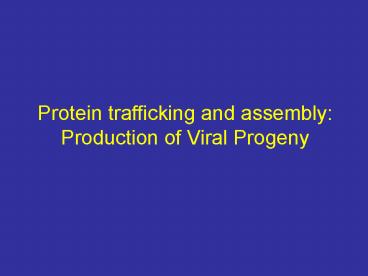Protein trafficking and assembly: - PowerPoint PPT Presentation
1 / 32
Title:
Protein trafficking and assembly:
Description:
Extravagant diversity in viral morphology. - Arises via the different proteins that are ... Associated with a cytosolic GTPase Activating Protein (Ran-GAP) ... – PowerPoint PPT presentation
Number of Views:128
Avg rating:3.0/5.0
Title: Protein trafficking and assembly:
1
Protein trafficking and assembly Production of
Viral Progeny
2
(No Transcript)
3
Extravagant diversity in viral morphology. -
Arises via the different proteins that are
produced and assembled.
4
Different viral genomes Blah Blah Blah
5
Acquisition of viral envelope
6
Map of HIV genome (9000 bases). Green gag
(capsid proteins) pol (reversetranscriptase)
env (envelope proteins) Red Other genes for
producing proteins reqd for viral life-cycle. -
some of which modify the host cell processes
(e.g. protein trafficking down regulation of
host protein synthesis).
7
- Modes of Viral capsid introduction
- Membrane fusion and cytosolic deposit
- B) Trigger Host Receptor-mediated endocytosis
cytosolic deposit - C) Non-enveloped forms a pore in membrane and
deposits RNA into cytosol - D) Combination Rec. mediated Endo. Cytosis
endosome escape, Nuclear deposit
8
(No Transcript)
9
- Example of Influenza uncoating strategy
- Receptor docking at PM
- Induction of Receptor-mediated Endocytosis
- Acidification of the endosome lumen triggers
- membrane fusion
- Genome extruded through lysed endosome.
10
How do cells know where proteins belong?
- Signal sequences!
- Some times proteins will have several signal
sequences to direct its - destination.
- e.g.) a PM protein must first have a signal to
get to the ER and then a signal to get trafficked
(via vesicles) to the PM. - Most signal peptides are removed by signal
peptidases.
11
- Nuclear Transport
- - Occurs through a Nuclear Pore complex
- - made up of gt100 proteins
- Allows free diffusion of molecules lt 9nm in
diameter - However, proteins gt25nm diameter pass through as
well, but require - energy to do so.
- Also, proteins can be accumulated against a
concentration gradient - inside of the nucleus.
12
(No Transcript)
13
(No Transcript)
14
- Nuclear Import Receptors
- Soluble cytosolic proteins that recognize and
bind to the NLS - Also bind to the nucleoporins at the extended
fibrils - Fibrils contain short amino acid repeats with Phe
Gly (i.e. FG-repeats) that serve as Import
receptor binding sites.
15
- Movement in and out of the nucleus is controlled
by a molecular - switch - Ran.
- Associated with a cytosolic GTPase Activating
Protein (Ran-GAP). - Also, has a nuclear Guanine Exchange Factor
(Ran-GEF). - Thus, the cytosol predominately has Ran(GDP)
nucleus Ran(GTP)
16
However, some viruses skip the export step.
17
- In this case all proteins required to synthesize
the - capsid have been imported into the nucleus,
assembled, - and then exits via vesicularization directly
into the ER.
18
Membrane Proteins Anyone?
19
(No Transcript)
20
(No Transcript)
21
(No Transcript)
22
(No Transcript)
23
- Membrane spanning proteins need an additional
signal. - Stop-transfer peptide signal which directs the
translocon to open and release the peptide
laterally. - Initial ER signal acts as the start-transfer
signal, but is cleaved
24
(No Transcript)
25
All N-linked oligosaccharides in the ER start
out the same. - Carbohydrates undergo
extensive modification almost
immediately. eg.) - glucose trimming
re-glucosylation -
Mannose trimming ER - Mannose trimming
Golgi - complex glycosylation golgi
core glycosylation (shaded in gray) of
five sugars remain in virtually all
glycosylated proteins.
26
Protein glycosylation There is one OS
trans. per translocon. It catalyzes the
transfer of the core oligosaccharide
from dolicohol to the NXs/t sequence of the
nasent polypeptide.
Oligosaccharyl transferase
27
(No Transcript)
28
Electron micrographs of the separate types of
coated vessicles
29
Trafficking direction is mediated in part by the
appropriate coat.
30
Viral proteins must have evolved to mimic
adaptin-binding molecules
31
(No Transcript)
32
(No Transcript)

